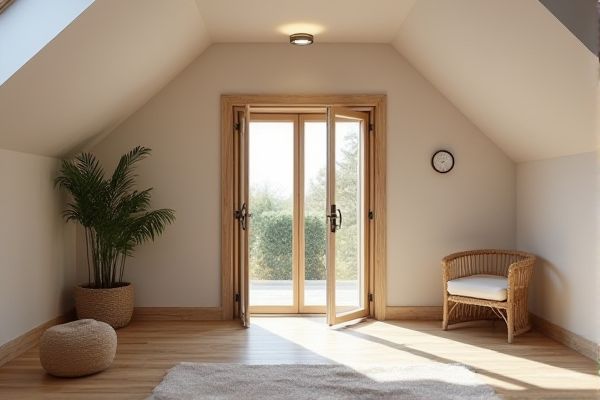
Attic folding doors maximize space with their compact, accordion-like design, ideal for tight areas, while pocket doors slide smoothly into wall cavities, offering a sleek, seamless look without swinging clearance. Explore the rest of the article to discover which door type best suits your attic renovation needs.
Table of Comparison
| Feature | Attic Folding Doors | Pocket Doors |
|---|---|---|
| Space Efficiency | Highly space-saving, folds compactly inside attic openings | Saves floor space by sliding into wall cavity |
| Installation | Moderate complexity, requires frame adjustments | Complex, needs wall cavity and structural modifications |
| Cost | Moderate price, affordable for attic spaces | Higher cost due to hardware and construction work |
| Durability | Durable materials suited for attic conditions | Durable sliding mechanism but prone to track issues |
| Maintenance | Low maintenance; simple hinge mechanism | Requires regular track cleaning and lubrication |
| Aesthetic Appeal | Functional, can be customized with finishes | Sleek, modern look with flush wall appearance |
| Sound Insulation | Moderate sound insulation | Better sound insulation if properly sealed |
| Use Case | Ideal for attic entrances and compact spaces | Suitable for rooms needing space-saving door solutions |
Introduction to Attic Folding Doors and Pocket Doors
Attic folding doors offer space-saving solutions with multi-panel construction that folds neatly to the side, ideal for small or irregular attic spaces. Pocket doors slide horizontally into a concealed wall cavity, maximizing usable floor area and enhancing room aesthetics by eliminating door swing clearance. Both options provide efficient access and flexibility for attic renovations, with folding doors better suited for wider openings and pocket doors perfect for narrow spaces.
Key Differences Between Folding and Pocket Doors
Attic folding doors consist of hinged panels that fold together, allowing for flexible space management and easier access in tight attic areas. Pocket doors slide horizontally into a wall cavity, offering a sleek, space-saving solution without protruding panels. Folding doors are ideal for irregular or smaller openings, while pocket doors require adequate wall space for installation and provide a seamless, modern appearance.
Space-Saving Benefits: Attic Folding vs. Pocket Doors
Attic folding doors maximize space by collapsing inward along multiple panels, making them ideal for tight or awkward attic entries where full door swings are impractical. Pocket doors slide into the wall cavity, completely freeing up floor space, but require sufficient wall thickness and structural modifications that may not be feasible in all attic settings. Comparing the two, attic folding doors offer flexible installation with moderate space-saving, while pocket doors provide the most floor clearance but demand more complex construction.
Installation Requirements for Each Door Type
Attic folding doors require minimal wall space and are typically easier to install in tight or irregular openings, using tracks mounted inside the attic frame. Pocket doors demand more structural modification, as the wall cavity must be hollowed out to house the door when fully opened, requiring careful framing and drywall work. Your choice depends on the available space and willingness to accommodate the more complex installation process of pocket doors.
Design and Aesthetic Options for Attic Folding and Pocket Doors
Attic folding doors offer versatile design options with customizable panel styles, finishes, and materials that complement varied attic interiors while maximizing space efficiency. Pocket doors provide a sleek, minimalist appearance by sliding seamlessly into the wall, ideal for maintaining clean lines and a modern aesthetic in compact attic spaces. Your choice depends on whether you prioritize decorative flexibility or a streamlined, unobtrusive look for your attic access.
Accessibility and Functionality Comparison
Attic folding doors offer enhanced accessibility by folding neatly to the side, requiring minimal clearance and allowing full access to the attic space without obstruction. Pocket doors slide horizontally into the wall cavity, saving floor space but may limit accessibility due to their narrower openings and potential track maintenance issues. Both door types provide functional solutions for attic entry, with folding doors favoring ease of access and pocket doors excelling in space-saving design.
Durability and Maintenance Considerations
Attic folding doors typically offer greater durability due to their robust hinges and solid panel construction, making them suitable for frequent use in tight spaces. Pocket doors require well-maintained sliding mechanisms and tracks, which can accumulate dust and debris, leading to potential maintenance challenges and repairs over time. Choosing attic folding doors can reduce upkeep efforts, ensuring your access remains smooth and reliable with minimal intervention.
Cost Comparison: Folding Doors vs. Pocket Doors
Folding doors generally cost less than pocket doors due to simpler installation and fewer structural modifications required. Pocket doors often involve higher labor and material expenses because of wall cavity alterations and specialized hardware. By choosing folding doors, you can optimize your budget while maintaining functional and stylish access to your attic space.
Best Use Cases for Attic Folding and Pocket Doors
Attic folding doors are ideal for spaces with limited headroom and irregular shapes, as their compact folding design maximizes accessibility without encroaching on room space. Pocket doors work best in areas where wall space can accommodate a sliding door that disappears into the wall cavity, perfect for saving space in narrow hallways or small rooms. Choosing the right door depends on your specific attic layout and how you want to optimize your available space efficiently.
Choosing the Right Door for Your Attic Space
Attic folding doors maximize space efficiency by folding neatly along one side, ideal for tighter or irregularly shaped attic areas, while pocket doors slide seamlessly into the wall, providing unobstructed access and a sleek appearance. Your choice depends on the attic's structural layout and how much room you can allocate for door operation. Prioritizing ease of use, space-saving potential, and aesthetic harmony ensures the right door enhances both functionality and style in your attic space.
 homyna.com
homyna.com